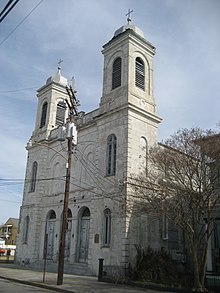Faubourg Marigny
Formerly part of a plantation, this area was developed by Creole landowner Bernard de Marigny, beginning in the early 19th century.
Sales of the affordable, modest-sized lots were spurred in 1831 when the Pontchartrain Railroad, or “Smoky Mary,” began running on Elysian Fields Avenue.
This neighborhood, like the portion of the Faubourg Marigny located across St. Claude Avenue, was settled primarily by Louisiana Creoles of color and German immigrants between the 1830s and 1880s.
Ferdinand LaMothe, better known as Jelly Roll Morton, would sneak away from his upright Creole grandmother's home, just off Elysian Fields Avenue, to play piano in the red light district of Storyville.
Sidney Bechet, Manny Perez, Danny Barker, and Paul Barbarin, all giants of New Orleans music, made their homes in the neighborhood.
In the 21st century, this area is the site of both funk palaces such as the Saturn Bar on St. Claude Avenue and 19th-century icons such as the St. Roch Market.
[6] Longstanding oaks line St. Roch and Elysian Fields avenues, where Creole cottages and shotgun houses are being renovated and painted.
In the early 19th century, the New Marigny was where white Creole gentlemen set up households for their mistresses of color (and their offspring) in the tradition of "plaçage.
The neighborhood declined badly in the mid-20th century, and the area around Washington Square was nicknamed "Little Angola" (after the prison of that name) for the dangerous criminals there.
The Faubourg Marigny is one of the city's most colorful neighborhoods; the architecture borrows heavily from the colonial French and Spanish and has elements of the Caribbean.
The section on the Mississippi River side of Rampart experienced some wind damage, but it was at a high enough elevation to escape the great flood.




